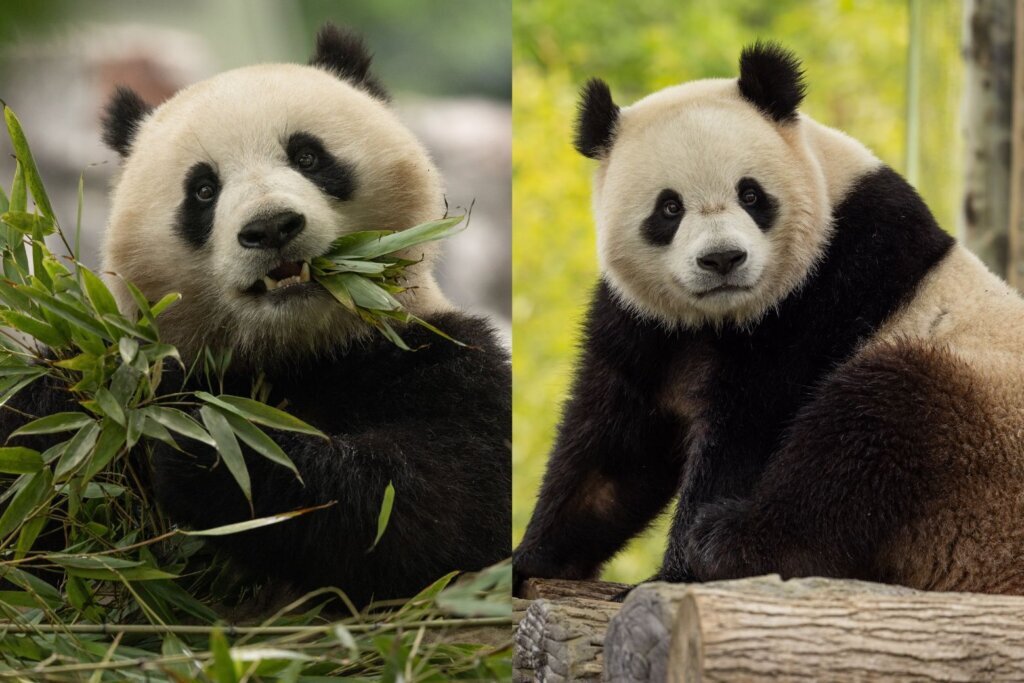This video is no longer available.
After a long and bittersweet farewell last November when D.C.’s giant pandas embarked to China on a FedEx plane, giant pandas are coming back to the nation’s capital.
The Smithsonian National Zoo announced Wednesday that two new pandas, Bao Li and Qing Bao, will be transported to the zoo by the end of the year.
Brandie Smith, the zoo’s John and Adrienne Mars director, said resuming the giant panda conservation program partnership with China proves that the institution’s “collaboration with Chinese colleagues has made an irrefutable impact.”
Bao Li is a descendant of the Smithsonian’s former “panda family.” The two-year-old male panda is the son of Bao Bao, who was born at the D.C. zoo in 2013.
“Through this partnership, we have grown the panda population, advanced our shared understanding of how to care for this beloved bear and learned what’s needed to protect wild pandas and preserve native habitat,” Smith said.
The zoo signed a new research and breeding agreement with the Chinese that runs through April 2034. According to a release, similar to previous agreements, any cubs born at the zoo will move to China by age 4. The zoo will pay a $1 million annual fee to the China Wildlife Conservation Association to support research and conservation efforts in China.
The FedEx “Panda Express” will be called into service again to transport the giant pandas from China to the D.C. zoo. The pandas will then be placed in quarantine and settle into their habitat for a few weeks before the institution’s animal care team decides that the pandas are ready for their public debut.
The zoo has taken advantage of the pandas’ time away, working to upgrade their exhibit with a variety of renovations.
Smith, first lady Jill Biden and Smithsonian Secretary Lonnie G. Bunch announced the imminent arrival of new giant pandas in a video Wednesday morning.
The ambassador also highlighted how D.C.-area residents were saddened by the departure of Tian Tian, Mei Xiang and Xiao Qi Ji last November.
“Many American friends, especially children, were reluctant to say goodbye,” Feng said. “A few days later, President Xi Jinping announced in San Francisco that China is ready to continue its cooperation with the United States on panda conservation, so as to deepen the friendly ties between our two peoples.”
That announcement came after Chinese President Xi Jinping and President Joe Biden held their first face-to-face meeting in a year. Feng also highlighted China and U.S. diplomatic ties during the Wednesday announcement.
“If there should be any protectionism, then let us protect biodiversity, protect the only home for the entire humanity. Protect a stable, sound and sustainable Sino-U.S. relations and protect a better future for the younger generations,” he said. “I encourage everyone to care for China-U.S. relations, just as you care for pandas, and jointly ushering in a peaceful and prosperous future.”

The panda program from China has long been used for diplomacy. In recent years, China has lent out pandas to Russia and Qatar. But diplomatic relations with the U.S. have been a little rockier, and China has begun gradually withdrawing its giant pandas from zoos in the U.S. and Europe.
According to The Associated Press, the Chinese Embassy held an event for a video series about friendship between people in China and the U.S. two weeks ago. Smith gave an emotional speech recounting her experience with giant pandas.
Word of the new exchange agreement spread quickly through the National Zoo grounds Wednesday, with multiple signs announcing “The Pandas Are Coming!” and fresh displays of panda-themed merchandise holding a prominent place in the gift shops.
Sofia Valle, an 8th grader from Bear, Delaware, came with a school group hoping to see pandas and unaware that the zoo is currently panda-free. Instead she and her classmates — all wearing panda-ear headbands — posed for pictures in front of a Giant Panda statue and discussed coming back after the new bears arrive.
“They’re my favorite animal,” Valle said. “They’re so fluffy! And they’re lazy like me.”
A research and breeding agreement with the Chinese runs through April 2034 and, like previous ones, says any cubs born at the zoo will move to China by age 4, according to the announcement. The zoo will pay a $1 million annual fee to the China Wildlife Conservation Association to support research and conservation efforts in China.
They were a gift after a historic trip to China
In 1972, 25 years of isolation between the U.S. and the People’s Republic of China came to an end when President Richard Nixon paid a visit to China that established diplomatic relations between the two countries.
While at a dinner in February 1972 during the seminal trip, first lady Pat Nixon mentioned her fondness for the giant pandas to Chinese Premier Zhou Enlai. After, the premier gifted two giant pandas to the American people as “gesture of good will,” according to the National Zoo’s website.
Ling-Ling (a female) and Hsing-Hsing (a male) arrived at the National Zoo later that year in April, drawing millions of fans from around the world to the zoo. The pair spent 20 years together, giving birth to five cubs. Unfortunately, none survived.
Ling-Ling died in 1992 from heart failure. She was 23. Due to age-related illnesses and a terminal kidney disease, Hsing-Hsing was euthanized in 1999 at age 28.
More than a year after the death of the zoo’s first panda pair, Mei Xiang (female) and Tian Tian (male) arrived at the zoo. Unlike Ling-Ling and Hsing-Hsing, the couple were on loan following an agreement wherein the two would live at the zoo for 10 years in exchange for $10 million and the sharing of conservation effort expertise with China.
The zoo renewed its Giant Panda Cooperative Research and Breeding Agreement with the China Wildlife Conservation Association three times since 2000.
What Smithsonian scientists learned about panda behavior and breeding
Smithsonian scientists and animal care staff learned a great deal about panda breeding, cub development and panda native habitats, leading to valuable insights about how to care for them and conserve wild panda populations.
After several natural and artificial breeding attempts, Mei Xiang give birth to Tai Shan in 2005. Tai Shan left the zoo for the Wolong Nature Reserve in China in 2010.
Mei Xiang gave birth to Bao Bao in 2013 and to Bei Bei in 2015. Bao Bao left for China in 2017. Bei Bei left in 2019.
In August 2020, Mei Xiang give birth to a male cub, Xiao Qi Ji. Later in December, the zoo announced another three-year extension with the China Wildlife and Conservation Association.
In September 2023, as the latest agreement drew to a close, the National Zoo held “Panda Palooza: A Giant Farewell” about a month before Mei Xiang, Tian Tian and their cub left for China.
The Associated Press contributed to this report.
Get breaking news and daily headlines delivered to your email inbox by signing up here.
© 2024 WTOP. All Rights Reserved. This website is not intended for users located within the European Economic Area.









